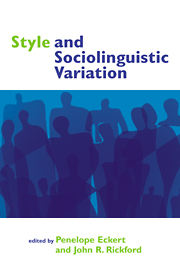Book contents
- Frontmatter
- Contents
- List of figures
- List of tables
- List of contributors
- Acknowledgments
- Introduction: John R. Rickford and Penelope Eckert
- Part I Anthropological approaches
- Part 2 Attention paid to speech
- 5 The anatomy of style-shifting
- 6 A dissection of style-shifting
- 7 Style and social meaning
- 8 Zeroing in on multifunctionality and style
- Part 3 Audience design and self-identification
- Part 4 Functionally motivated situational variation
- References
- Index
6 - A dissection of style-shifting
Published online by Cambridge University Press: 07 December 2009
- Frontmatter
- Contents
- List of figures
- List of tables
- List of contributors
- Acknowledgments
- Introduction: John R. Rickford and Penelope Eckert
- Part I Anthropological approaches
- Part 2 Attention paid to speech
- 5 The anatomy of style-shifting
- 6 A dissection of style-shifting
- 7 Style and social meaning
- 8 Zeroing in on multifunctionality and style
- Part 3 Audience design and self-identification
- Part 4 Functionally motivated situational variation
- References
- Index
Summary
This review begins with a survey of Labov's contributions to stylistic and contextual research in sociolinguistics, including some observations about the evidence presented in chapter 5. After reinterpreting some of that data we pay brief tribute to Labov's sociolinguistic legacy. We then turn to some methodological considerations that are relevant to scholars who conduct linguistic analyses of style-shifting derived from combinations of recordings, experiments, questionnaires, and observations, all of which are ultimately intended to provide reliable and representative linguistic corpora that are amenable to rigorous scientific inquiry.
Labov begins his chapter by reviewing taxonomies of style and their uses. He acknowledges the desire “to know as much as possible about the ways that speakers shift forms and frequencies in the course of every-day life,” and he confirms the complexity of this exceedingly difficult task. These remarks presume familiarity with Labov's discussion (chapter 5), and I hope to offer additional insights growing from some of Labov's earlier discussions about style. Various stylistic taxonomies, including most of those presented throughout this book, represent alternative heuristic approaches to alternative stylistic genres. The Labovian paradigm has largely been associated with quantitative studies of linguistic variation and change in progress. Evidence for these studies has been gathered in different contexts, and the definitions of those contexts have evolved during the past thirty years.
These opening remarks focus on four stylistic trends that can be traced in Labov's work: the first trend grows from his 1966 dissertation, “The Social Stratification of English in New York City.”
- Type
- Chapter
- Information
- Style and Sociolinguistic Variation , pp. 109 - 118Publisher: Cambridge University PressPrint publication year: 2002
- 1
- Cited by



